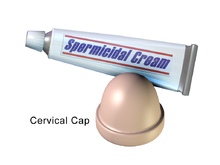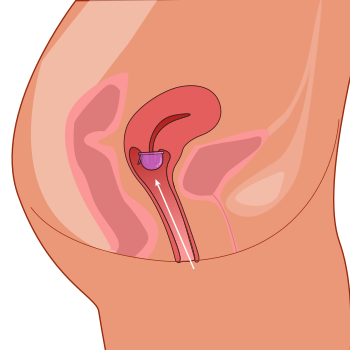Cervical cap
The term cervical cap has been used to refer to a number of barrier contraceptives, including the Prentif, Dumas, Vimule, and Oves devices.
[1] During this time, it was common to use the term cervical cap to refer exclusively to the Prentif brand.
[4][5] Other sources include FemCap in the term cervical cap, but classified the Lea's Shield as a distinct device.
Most commonly the Pearl Index is used to calculate effectiveness rates, but some studies use decrement tables.
The study authors estimate that for nulliparous women (those who have never given birth) the pregnancy rate in typical use may be lower, around 5% per year.
Since the cervical cap can be worn for longer periods of time than the diaphragm, it is more prone to develop odors which might begin to appear after three continuous days of wear.
[1] The other devices are the latex Dumas and Vimule, and the silicone FemCap, Lea's Shield, and Shanghai Lily.
Unlike the other caps, Lea's Shield has a one-way air valve that helps it seal to the vaginal walls.
[citation needed] As of February 2009, FemCap was the only brand of cervical cap available in the United States.
[27] FemCap is also available in the UK via the NHS on prescription and is often distributed free from Family Planning Clinics depending on the health authority.
[32] This cap of the 1920s (the "Mizpah") had a separate ring (rim) which went around the base of the cervix and was worn constantly.
A criticism of it was that due to the groove in the base ring (so it could attach itself to the cap part) it could not be kept perfectly clean without removing it.
The high dome cap is allegedly less likely to become dislodged should the penis push hard against the cervix.
Some thought it was too flimsy and more likely to dislodge, but Stopes had (in the 1920s) claimed just the opposite for this design, as did the director of a woman's health center who tried it out.
Women who have given birth may have scar tissue or irregularly shaped cervixes that interfere with the cap forming a good seal.
[41] In infrequent cases a woman may have a long vagina but short fingers and thus may not be able to place the cap correctly.
[44] The first step in inserting or removing a cervical cap is hand washing, to avoid introducing harmful bacteria into the vaginal canal.
[50] The Oves cap and the new version of the FemCap performed poorly in user acceptability studies.
Others made sticky mixtures that included honey or cedar rosin, to be applied to the os.
[54] The modern idea of a cervical cap as a fitted device that seals itself against the vaginal walls is of more recent origin; it emerged within the past century.
In 1838, German gynecologist Friedrich Wilde created the first modern cervical cap by making custom-made rubber molds of the cervix for some of his patients.
An important precursor to the invention of more lasting caps was the rubber vulcanization process, patented by Charles Goodyear in 1844.
Foote, a U.S. physician claims to have invented the cervical cap but it's reported that his patent was denied since the device could be used for obscene purposes.
An occlusive pessary marketed in the United States as the "womb veil" seems to have been an early form of diaphragm or cervical cap.
[56] Over the next several decades, the cervical cap became the most widely used barrier contraceptive method in Western Europe and Britain.
Lamberts (Dalston) Ltd., the only manufacturer at that time, failed to provide this information, and the FDA banned the use of cervical caps in the United States.
[57] In the late 1970s, the FDA reclassified the cervical cap as an investigational device, and it regained limited availability.
[63] Within a few years, the FDA withdrew investigational status from the Vimule cap, following a study that associated its use with vaginal lacerations.
[66] The feminist movement played a large role in re-introducing the cervical cap to the United States.
[69] A cervical cap is very likely the contraceptive that maid Anna Bates buys for her mistress Lady Mary Crawley in the second episode of the fifth series of the period drama Downton Abbey.

